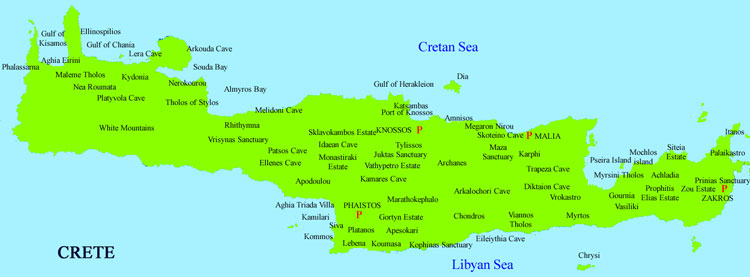.

Karfi, (Karphi) Crete, is a little-visited archaeological site high in the Dikti Mountains that is the Macchu Picchu of Minoan civilization. When the warlike mixed group conventionally referred to as Dorians arrived in Crete from the Peloponnese after ca 1100 BC, archaeological reconstructions suggest that they would have found the Minoan people living along with the Mycenaeans, surviving as an underclass. No doubt the Minoan language continued to be spoken by the peasants, though inscriptions, now in Linear B, were all in a form of Greek associated with a Mycenaean upper class (BBC).
The Dorians seem to have driven the local people up into the hills; the latest towns with Minoan material culture are in more and more inaccessible places, the last one being at Karfi, high in the Dikti Mountains, though the date range for the site is broad. There are house complexes, a tripartite megara-type building with hearth and a sanctuary, where votive figures were found.
At Karfi the last of the Eteocretan Minoan settlements retreated to the slopes of this barren mountain, from which they had a view of the Sea of Crete, the valley of Pediada, and the plateau of Lassithi with Iraklion, where the finds from Karfi are now displayed in the Archaeological Museum (Room 11). In the mountains of Eastern Crete a non-Greek language was still being spoken and sometimes inscribed into Classical times, and the people who spoke it were still identified as "Eteocretans"— "true Cretans".
The peak of Karfi was originally a peak sanctuary, occupying a typical site on a high shoulder with a wide "viewshed" (Soetens, Driessen et al.) that connected it with sightlines to other sites, typical of the network developed in the "first Palace period" (Middle Minoan IB–II, 1900–1800BC) onwards, but probably abandoned, perhaps under increased religious centralization, in Middle MinoanIIIA (ca 1650BC) (Soetens, Driesen et al.). The rocky site that the last of the Minoans returned to is dominated by a bifurcated stone outcropping [1] that is unmistakably like the carved and shaped crescent horn stone altars known in Crete and Cyprus [2]. At this high remote ancient sacred site a fragment of Minoan civilization survived intact for about 400 years after the occupation of Knossos. Several clay religious figurines have been found there including the cylindrical skirted goddesses in cylindrical skirts with their hands raised in the epiphany gesture.
J. D. S. Pendlebury and the British Archaeology School extensively excavated the ruins in the 1930s.
References
BBC: The Minoan Civilization: cultural overview to put Karfi in context
Archaeological Atlas of the Aegean: 589. Karfi
S. Soetens, J. Driessen, A. Sarris, S. Topouzi, "The Minoan peak sanctuary landscape through a GIS approach" at XIV Congrès de l'Union International des Sciences Perhistoriquews et Protohistorique, Liège 2001 (pdf file)
Photos from a hiker's point of view, omitting the outcrops.
Iraklion Archaeological Museum: Room 11, ceramics from Karfi
| Ancient Greece
Science, Technology , Medicine , Warfare, , Biographies , Life , Cities/Places/Maps , Arts , Literature , Philosophy ,Olympics, Mythology , History , Images Medieval Greece / Byzantine Empire Science, Technology, Arts, , Warfare , Literature, Biographies, Icons, History Modern Greece Cities, Islands, Regions, Fauna/Flora ,Biographies , History , Warfare, Science/Technology, Literature, Music , Arts , Film/Actors , Sport , Fashion --- |
Retrieved from "http://en.wikipedia.org/"
All text is available under the terms of the GNU Free Documentation License


